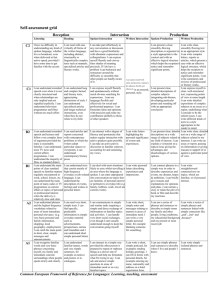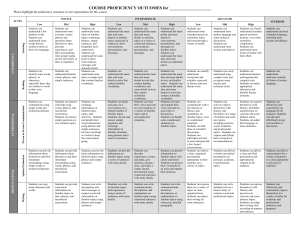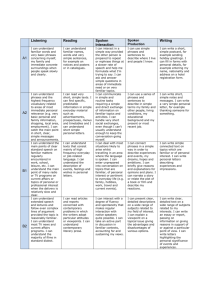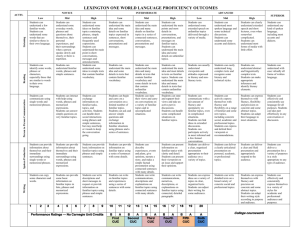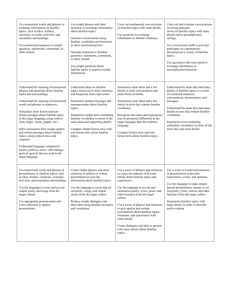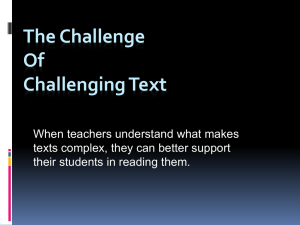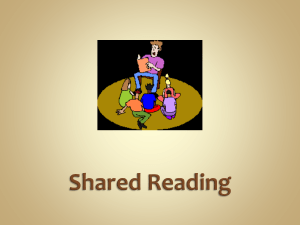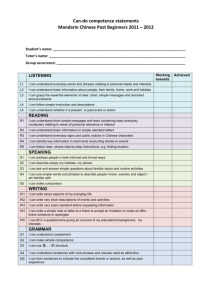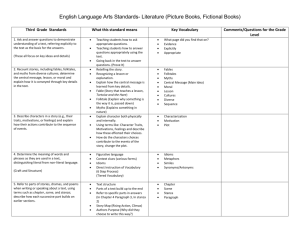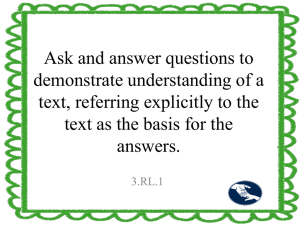Course Proficiency Outcomes
advertisement
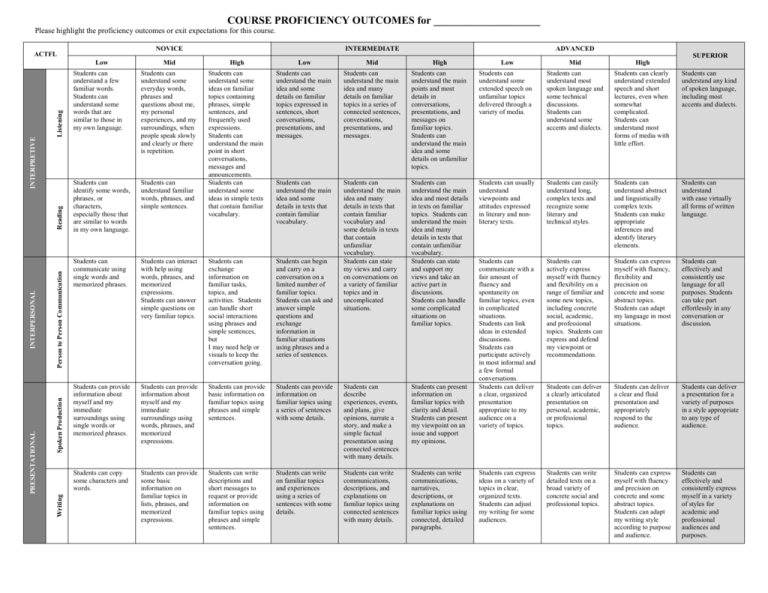
COURSE PROFICIENCY OUTCOMES for ____________________ Please highlight the proficiency outcomes or exit expectations for this course. NOVICE ACTFL Listening Writing Spoken Production Person to Person Communication Reading INTERPRETIVE INTERPERSONAL PRESENTATIONAL INTERMEDIATE ADVANCED SUPERIOR Low Mid High Low Mid High Low Mid High Students can understand a few familiar words. Students can understand some words that are similar to those in my own language. Students can understand some everyday words, phrases and questions about me, my personal experiences, and my surroundings, when people speak slowly and clearly or there is repetition. Students can understand the main idea and some details on familiar topics expressed in sentences, short conversations, presentations, and messages. Students can understand the main idea and many details on familiar topics in a series of connected sentences, conversations, presentations, and messages. Students can understand the main points and most details in conversations, presentations, and messages on familiar topics. Students can understand the main idea and some details on unfamiliar topics. Students can understand some extended speech on unfamiliar topics delivered through a variety of media. Students can understand most spoken language and some technical discussions. Students can understand some accents and dialects. Students can clearly understand extended speech and short lectures, even when somewhat complicated. Students can understand most forms of media with little effort. Students can understand any kind of spoken language, including most accents and dialects. Students can identify some words, phrases, or characters, especially those that are similar to words in my own language. Students can understand familiar words, phrases, and simple sentences. Students can understand some ideas on familiar topics containing phrases, simple sentences, and frequently used expressions. Students can understand the main point in short conversations, messages and announcements. Students can understand some ideas in simple texts that contain familiar vocabulary. Students can understand the main idea and some details in texts that contain familiar vocabulary. Students can easily understand long, complex texts and recognize some literary and technical styles. Students can understand abstract and linguistically complex texts. Students can make appropriate inferences and identify literary elements. Students can understand with ease virtually all forms of written language. Students can interact with help using words, phrases, and memorized expressions. Students can answer simple questions on very familiar topics. Students can exchange information on familiar tasks, topics, and activities. Students can handle short social interactions using phrases and simple sentences, but I may need help or visuals to keep the conversation going. Students can begin and carry on a conversation on a limited number of familiar topics. Students can ask and answer simple questions and exchange information in familiar situations using phrases and a series of sentences. Students can understand the main idea and most details in texts on familiar topics. Students can understand the main idea and many details in texts that contain unfamiliar vocabulary. Students can state and support my views and take an active part in discussions. Students can handle some complicated situations on familiar topics. Students can usually understand viewpoints and attitudes expressed in literary and nonliterary texts. Students can communicate using single words and memorized phrases. Students can understand the main idea and many details in texts that contain familiar vocabulary and some details in texts that contain unfamiliar vocabulary. Students can state my views and carry on conversations on a variety of familiar topics and in uncomplicated situations. Students can actively express myself with fluency and flexibility on a range of familiar and some new topics, including concrete social, academic, and professional topics. Students can express and defend my viewpoint or recommendations. Students can express myself with fluency, flexibility and precision on concrete and some abstract topics. Students can adapt my language in most situations. Students can effectively and consistently use language for all purposes. Students can take part effortlessly in any conversation or discussion. Students can provide information about myself and my immediate surroundings using single words or memorized phrases. Students can provide information about myself and my immediate surroundings using words, phrases, and memorized expressions. Students can provide basic information on familiar topics using phrases and simple sentences. Students can provide information on familiar topics using a series of sentences with some details. Students can describe experiences, events, and plans, give opinions, narrate a story, and make a simple factual presentation using connected sentences with many details. Students can present information on familiar topics with clarity and detail. Students can present my viewpoint on an issue and support my opinions. Students can communicate with a fair amount of fluency and spontaneity on familiar topics, even in complicated situations. Students can link ideas in extended discussions. Students can participate actively in most informal and a few formal conversations. Students can deliver a clear, organized presentation appropriate to my audience on a variety of topics. Students can deliver a clearly articulated presentation on personal, academic, or professional topics. Students can deliver a clear and fluid presentation and appropriately respond to the audience. Students can deliver a presentation for a variety of purposes in a style appropriate to any type of audience. Students can copy some characters and words. Students can provide some basic information on familiar topics in lists, phrases, and memorized expressions. Students can write descriptions and short messages to request or provide information on familiar topics using phrases and simple sentences. Students can write on familiar topics and experiences using a series of sentences with some details. Students can write communications, descriptions, and explanations on familiar topics using connected sentences with many details. Students can write communications, narratives, descriptions, or explanations on familiar topics using connected, detailed paragraphs. Students can express ideas on a variety of topics in clear, organized texts. Students can adjust my writing for some audiences. Students can write detailed texts on a broad variety of concrete social and professional topics. Students can express myself with fluency and precision on concrete and some abstract topics. Students can adapt my writing style according to purpose and audience. Students can effectively and consistently express myself in a variety of styles for academic and professional audiences and purposes. Course Proficiency Outcomes Brainstorming: Record your ideas for helping your students reach the proficiency outcomes for each standard. Essential Standard #1: Interpersonal Communication Essential Standard #2: Interpretive Communication Essential Standard #3: Presentational Communication Essential Standard #4: Culture
